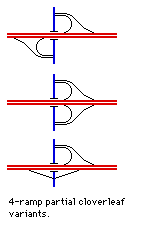Diamonds and other 4-ramp interchanges

The basic diamond is often the design of choice for lower-traffic interchanges without special constraints.
It does not scale up well to heavy traffic on the surface street or ramps, or if there is heavy left-turning traffic. Traffic signals can be installed at the two points where the ramps meet the surface street, but high enough traffic volumes can cause backups on the street and the ramps -- even resulting in stopped traffic on the freeway. All ramps function to connect the freeway to the surface street, as well as transition traffic from low speeds, or a dead stop, to freeway speeds. If a ramp also has the task of storing queued-up traffic, its length becomes a critical design factor.
Another problem: for higher traffic volumes, the surface street will need left turn lanes for the entrance ramps. (or right turn lanes, for countries where you drive on the left.) In a tight diamond, there's not much length between ramps available for turn lanes. Having turn lanes for each direction in parallel forces the roadway to be wider. If the surface road is on a bridge, where lanes are expensive to add, each left turn lane takes away a potential thru lane. In this case, the engineer can go for a solution which doesn't require left turns from the surface street: the six-ramp partial cloverleaf interchange. Another solution is the single-point diamond or "SPUI".

The interchanges above are called partial cloverleafs, or parclos, as they have loop ramps. (A full cloverleaf has eight ramps.) However, they're functionally equivalent to a diamond, with two entrance ramps and two exit ramps. These types of parclos are also known as folded diamonds, as one or more ramps are "folded" into a loop on the opposite side of the surface street.
Why are variants used? Sometimes the layout of the land, or property on it, creates a constraint. Sometimes traffic is better served if motorists can turn one way instead of the other. Sometimes nearby intersecting streets make a modified diamond a better solution than a conventional one.
Another diamond variation has left exits and entrances, so the ramps meet in the center. I-244 in Tulsa has a few of these (example). In America, left-hand exits have been deprecated for some time, as they conflict with the left lane's frequent task as a passing or high-speed lane. Though these inner diamonds concentrate ramp traffic at a single point in the center, the Single-point Urban Interchange achieves that with right-hand exit ramps.
A more benign diamond variant is the "roundabout interchange", where a roundabout is placed at the end of each exit ramp/entrance ramp intersection.
Links
- Interchanges
- Glossary
- Culture: interchanges in movies, computer games, etc.
- Diamond and other 4-ramp designs
- Six-ramp partial cloverleaf
- Cloverleaf
- Trumpet and other 3-way interchanges
- Stack and other heavy-duty 4-way interchanges
- Volleyball: an odd 3-level 4-way treatment
- SPUI: Single-Point Urban Interchange
- Oddities: Some strange or fictional interchanges